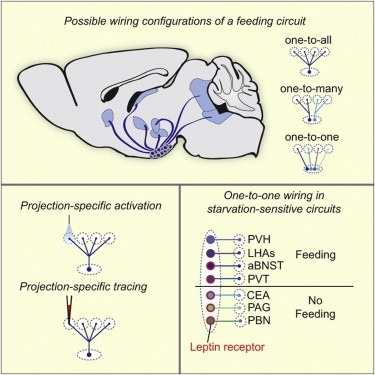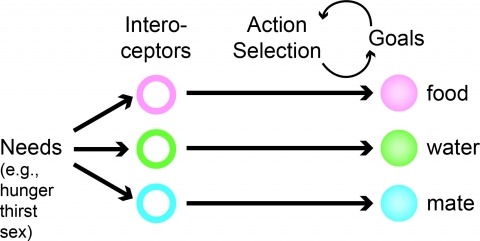Filter
Associated Lab
- Remove Sternson Lab filter Sternson Lab
3 Janelia Publications
Showing 1-3 of 3 resultsNeural circuits for essential natural behaviors are shaped by selective pressure to coordinate reliable execution of flexible goal-directed actions. However, the structural and functional organization of survival-oriented circuits is poorly understood due to exceptionally complex neuroanatomy. This is exemplified by AGRP neurons, which are a molecularly defined population that is sufficient to rapidly coordinate voracious food seeking and consumption behaviors. Here, we use cell-type-specific techniques for neural circuit manipulation and projection-specific anatomical analysis to examine the organization of this critical homeostatic circuit that regulates feeding. We show that AGRP neuronal circuits use a segregated, parallel, and redundant output configuration. AGRP neuron axon projections that target different brain regions originate from distinct subpopulations, several of which are sufficient to independently evoke feeding. The concerted anatomical and functional analysis of AGRP neuron projection populations reveals a constellation of core forebrain nodes, which are part of an extended circuit that mediates feeding behavior.
How does an organism’s internal state direct its actions? At one moment an animal forages for food with acrobatic feats such as tree climbing and jumping between branches. At another time, it travels along the ground to find water or a mate, exposing itself to predators along the way. These behaviors are costly in terms of energy or physical risk, and the likelihood of performing one set of actions relative to another is strongly modulated by internal state. For example, an animal in energy deficit searches for food and a dehydrated animal looks for water. The crosstalk between physiological state and motivational processes influences behavioral intensity and intent, but the underlying neural circuits are poorly understood. Molecular genetics along with optogenetic and pharmacogenetic tools for perturbing neuron function have enabled cell type-selective dissection of circuits that mediate behavioral responses to physiological state changes. Here, we review recent progress into neural circuit analysis of hunger in the mouse by focusing on a starvation-sensitive neuron population in the hypothalamus that is sufficient to promote voracious eating. We also consider research into the motivational processes that are thought to underlie hunger in order to outline considerations for bridging the gap between homeostatic and motivational neural circuits.
Neural processes that direct an animal’s actions toward environmental goals are critical elements for understanding behavior. The hypothalamus is closely associated with motivated behaviors required for survival and reproduction. Intense feeding, drinking, aggressive, and sexual behaviors can be produced by a simple neuronal stimulus applied to discrete hypothalamic regions. What can these "evoked behaviors" teach us about the neural processes that determine behavioral intent and intensity? Small populations of neurons sufficient to evoke a complex motivated behavior may be used as entry points to identify circuits that energize and direct behavior to specific goals. Here, I review recent applications of molecular genetic, optogenetic, and pharmacogenetic approaches that overcome previous limitations for analyzing anatomically complex hypothalamic circuits and their interactions with the rest of the brain. These new tools have the potential to bridge the gaps between neurobiological and psychological thinking about the mechanisms of complex motivated behavior.



